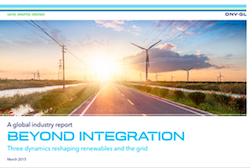According to a new survey from DNV GL, there is a global consensus that a renewables based electricity system can be achieved. More than 1,600 energy sector participants representing more than 70 countries participated in a study addressing three key  questions on how to move forward the integration of renewables into the global electricity grids of the future. Eight out of 10 respondents believe that the electricity system can be 70 percent renewable by 2050 while nearly half of the respondents believe this can be achieved in the next 15 years. The culmination of the study was published in the report, “Beyond Integration: Three dynamics reshaping renewables and the grid“.
questions on how to move forward the integration of renewables into the global electricity grids of the future. Eight out of 10 respondents believe that the electricity system can be 70 percent renewable by 2050 while nearly half of the respondents believe this can be achieved in the next 15 years. The culmination of the study was published in the report, “Beyond Integration: Three dynamics reshaping renewables and the grid“.
Key questions asked included posing a scenario in which renewables account for 70 percent of power sector generation. How likely did they feel this was to come about? What time frame might they assign to such a scenario? To whom would the scenario pose challenges? To whom might it offer opportunities?
The analysis sheds light on three dynamics reshaping renewables and the grid for the energy transition: convergence of metrics, rebalancing of rules and expansion of horizons.
David Walker, CEO DNV GL-Energy, said of the report, “DNV GL’s analysis of these findings concludes that the solution for a high renewables future demands a dramatic change in the industry’s approach to the integration of new technology. We need to adopt more collaborative approaches and go beyond old metrics, beyond old rules and beyond old silos. A shift away from a paradigm in which renewables are considered a nuisance to be accommodated to one in which the true potential of renewables in balancing and securing grids is unlocked. The debate needs to move ‘beyond integration’. DNV GL is taking the broader view and opening that discussion.”
Report findings are organised around three dynamics, which DNV GL sees reshaping not just electricity, but the entire energy sector:
- Convergence – New economic metrics must converge the needs of policymakers and system operators. The survey indicates that policymakers and system operators place diverging demands on renewable developers. Qualitative data stress that securing political will depends on affordability, while in a high renewables future developers must also engage with the increasing system operation challenges.
- Rebalancing – New rules are needed to rebalance the opportunities and challenges for developers and system operators. Developers, independent power producers and original equipment manufacturers are relishing the opportunities brought about by the shift to a high renewables system, while system operators and utilities identify themselves as being challenged by the transition.
- Expansion – New entrepreneurial solutions will expand the electricity business into a true ‘internet of energy’. Current high interest in energy storage, which 66 percent of respondents select as a top 3 lever for a high renewables future, is an example of the increasingly blurry lines between power, transport and heat. Meanwhile, respondents’ emphasis on smart grids underscores the role for IT in helping to manage the variability of renewables. The electricity sector is becoming more interconnected with the wider energy system, and also with newer sectors such as IT.

